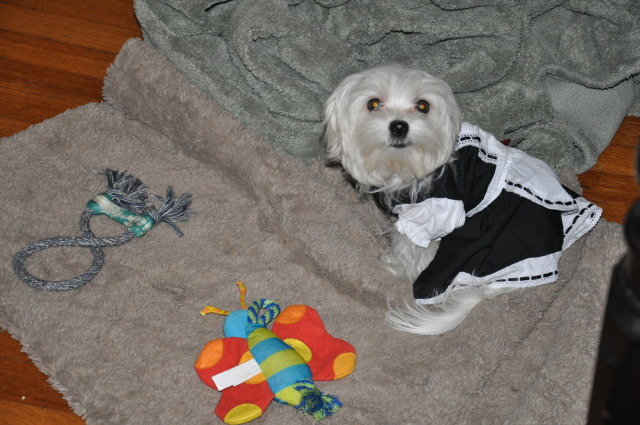QuestionI currently have a 6 month purebred Lhasa Apso and will be picking up a new 8 week Lhasa from the same breeder this weekend. I keep getting different answers on the best way to do this. I just don't want to start off on the wrong foot and spend my time correcting my mistake at my puppies expense.
I read the article about introducing a new puppy to an older dog, would your advise be the same?
Thank you for your assistance with this. I am very interested in getting everything going as best as possible so I can continue enjoying the wonderful relationship I am having with my puppies.
Dorene
AnswerHi Dorene,
You probably keep getting different answers on how to introduce your 6 month old puppy to a new puppy, because there are several ways to go about doing it.
I doubt there is a method of introduction which does not cause some degree of stress to your original resident dog, but since there's no way to explain yourself to the dog, it's a matter of being persistent, and loving, and knowing that in time the dust will settle, and one day your two dogs will be the best of friends.
Introduce the two dogs in neutral territory, a secure, fenced area works well. It helps to have another person who is not a family member with you to help control both dogs. Keep both dogs on a leash during the introduction, so that you can control the situation.
You can start by having a friend holding the puppy in their arms and letting your older dog take a good sniff. Then separate, put the puppy down and allow the dogs to approach one another at their own speed. Stay relaxed! The dogs can sense if you are tense. Verbal encouragement, such as "good dogs!" reinforce any good behavior with some tasty treats. If there is any aggression on either side, you will have to take a break and try again.
Opposite-sex introductions tend to go smoother than same-sex introductions, but since the one puppy is only 8 weeks old, that really shouldn't factor into things. Also, if your older dog is neutered or spayed, you will have an easier time.
Allow the dogs supervised access to one another for the first week or so, until the two form a good relationship and can be trusted alone together. Depending on the dogs, these may be five minutes to a few days, or longer.
Pick the largest play area possible so the dogs have room to move around. End the play session if the older dog repeatedly exhibits 'lay off me' behavior such as trying to avoid the puppy, snarling, growling or snapping. Remove all toys from the mutual play area to avoid possible fights over toys. If the puppy is fully vaccinated, walks together can reinforce positive, fun things happen when the dogs are together.
Although the dogs must develop their own social order, they must remember that you are still in charge. This means being fair on reprimands as well as affection. Any misbehavior, regardless of who started it, must be handled equally (and with consistency). When play gets too rough, all must be placed in a down-stay position or separated until calm is restored. Make the rules, and then back them up with necessary action!
Once you have both dogs in your home, provide them each a place to feel secure and unintimidated. Your first dog should be able to relax in his spot without worrying that he needs to protect it.
At meal time, feed at the same time but in separate areas of a room. Separate with a gate or in different rooms if either dog seems anxious.
The keys to success are patience and observation. Expect that the social system may shift. The dog that you always thought of as the "boss dog" may not only be relegated to a lower position, but may also prefer that.
Let the animals set their own pace. In some cases, the pets never become close companions but are reasonably content leading separate lives under the same roof. This is far more preferable to outright aggression. Do not push the animals too hard or push for relationships they clearly do not want; this could backfire and you could undo most of the good behavior that you had achieved.
Before the age of 4 months, puppies may not recognize subtle body postures from adult dogs which are signals they have had enough. Well-socialized adult dogs with good temperaments can set limits with puppies with a growl or snarl. These behaviors should be allowed. Adults which are not well socialized, or who have a history of fighting with other dogs may attempt to set limits with more aggressive behaviors such as biting which can harm the puppy.
For the most part, dogs adjust to puppies easily, but since the consequences of a problem can be severe, it is wise to follow a slow introduction process to ensure all goes well with adding a new puppy to your home.
I hope I've been a help.
Best of luck,
Patti

 Potty problems
Question
QUESTION: Hii Okay i have a 6 month old
Potty problems
Question
QUESTION: Hii Okay i have a 6 month old
 Nutrition & Health
Question
Peek-A-Boo!
Hello! I am new to owning small br
Nutrition & Health
Question
Peek-A-Boo!
Hello! I am new to owning small br
 Mini-Daschund Question
Question
Baby
I got a rescus mini about 6 years ago. &n
Mini-Daschund Question
Question
Baby
I got a rescus mini about 6 years ago. &n
 Puppy Teething, Jumping, Bathing and Ear drops
Question
Puppy Trinnie
Hi, I have a 5 & 1/2 month old S
Puppy Teething, Jumping, Bathing and Ear drops
Question
Puppy Trinnie
Hi, I have a 5 & 1/2 month old S
 Bedwetting and poop eating
QuestionQUESTION: We have a 12 week old beagle cross wh
Bedwetting and poop eating
QuestionQUESTION: We have a 12 week old beagle cross wh